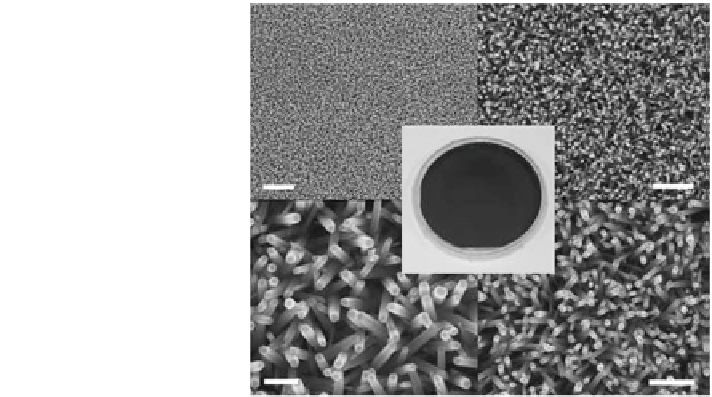Environmental Engineering Reference
In-Depth Information
Fig. 3 ZnO nanowire array
on a 4-inch (ca. 10 cm)
silicon wafer. At the center is
a photograph of a coated
wafer, surrounded by SEM
images of the array at
different locations and
magnifications. These images
are representative of the
entire surface. Scale bars,
clockwise from upper left 2,
1 mm. 500 and 200 nm.
Reproduced with permission
from [
24
]
the film. Mesoporous films heat-treated below 300 C appeared yellow, compared
to the red films obtained after annealing at higher temperatures. Prochazka et al.
synthesized the exceptionally dense TiO
2
films via dip-coating from a sol con-
taining poly(hexafluorobutyl methacrylate) as the structure-directing agent [
72
].
The TiO
2
films can be deposited on glass, F-doped SnO
2
, and crystalline silicon
(111) faces. Noriyuki et al. fabricated ZnO/Zn
0.85
Mg
0.15
O heterostructure thin
films by sol-gel spin-coating method on sapphire (0001) substrate [
66
]. The
bottom ZnO layer was prepared from zinc acetate dissolved in 2-methoxyethanol.
And, monoethanolamine was added to the solution until reaching the same molar
ratio with Zn ions. Its solution was deposited onto sapphire substrate by spin-
coating process, and then annealed in air at 280 C for 1 min to remove the
solvent. Likewise, Elfanaoui et al. used a very simple and low-cost sol-gel syn-
thesis technique to prepare granular TiO
2
film [
12
]. Thin films of TiO
2
were
deposited by the method of spin coating in air at room temperature, on corning
glass as substrate. The films were dried at 100 C for 1 h and annealed at 300, 350,
and 400 C in air during 1 h. They investigated the effect of the number of
coatings and the annealing temperature on the films as well.
In comparison to sol-gel spin-coating techniques, doctor-blading of thin films is
an even more simple and convenient method for creating ordered and mesoporous
nanostructures [
1
,
34
,
75
,
83
]. Films that are 10 lm thick can be fabricated with
relative ease using this method. For example, Kabre et al. prepared a Tin-doped
TiO
2
photoanodes with a thickness of 2 mm and a resistance of 8 X/sq on a
2.5 9 2.5 cm of FTO glass [
34
]. A TiO
2
slurry was prepared by grinding 2 g of
Degussa P25 TiO
2
powder in 3 mL of 10 % acetic acid for 30 min, followed by
addition of 1 drop of an aqueous 10 % Triton-X solution. The slurry was then
deposited on the conductive side of the glass plate using the doctor blade technique
with a mask made of 3 M tape applied to three sides of the plate. After air drying

Search WWH ::

Custom Search